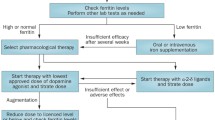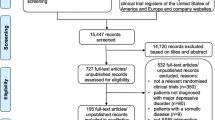Abstract
Purpose
Largely based on case series, several drugs have been implicated in drug-induced restless legs syndrome (RLS) including selective serotonin reuptake inhibitors (SSRI). We aimed to assess the association between initiation of SSRIs and RLS in a self-controlled design.
Methods
We conducted a symmetry analysis, including Danish adults who filled in their first prescription of an SSRI in the period of 1997–2017 and initiated an RLS drug (quinine, ropinirole, pramipexole or rotigotine) 1 year prior to or after this date. A symmetrical distribution of prescriptions before and after SSRI initiation is expected if there is no association between SSRI and RLS (a sequence ratio (SR) of 1.0). The symmetry analysis design is robust to confounders that are stable over time. Subgroup analyses were conducted, restricting the population on sex, age, selected diagnoses and concurrent medication.
Results
A total of 10,875 patients filled in their first-ever prescription of both an SSRI and an RLS drug within a 1-year interval; 5341 patients filled their prescription of SSRI prior to their prescription of an RLS drug, and 5534 patients redeemed their prescriptions in the opposite order (SR 0.97, 95% CI 0.93–1.00). Restricting the outcome to dopamine agonist initiation revealed a slightly increased sequence ratio (SR 1.34, 95% CI 1.24–1.46), which was reduced when adjusting for trends in prescription (adjusted SR 1.21, 95% CI 1.12–1.32). Restricting the outcome to quinine initiation showed no association.
Conclusion
We found no association between the initiation of an SSRI and the development of RLS assessed by the prescription of an RLS drug.


Similar content being viewed by others
Data availability statement
The data that support the findings of this study are available from the Danish Health Data Agency, but restrictions apply to the availability of these data and so are not publicly available. Data are however available from the Danish Health Data Agency for research purposes only.
References
Allen RP, Picchietti DL, Garcia-Borreguero D, Ondo WG, Walters AS, Winkelman JW et al (2014) Restless legs syndrome/Willis–Ekbom disease diagnostic criteria: updated international restless legs syndrome study group (IRLSSG) consensus criteria – history, rationale, description, and significance. Sleep Med 15(8):860–873
Ohayon MM, O’Hara R, Vitiello MV (2012) Epidemiology of restless legs syndrome: a synthesis of the literature. Sleep Med Rev 16(4):283–295
Trenkwalder C, Allen R, Högl B, Clemens S, Patton S, Schormair B, Winkelmann J (2018) Comorbidities, treatment, and pathophysiology in restless legs syndrome. Lancet Neurol 17(11):994–1005
Patatanian E, Claborn MK (2018) Drug-induced restless legs syndrome. Ann Pharmacother 52(7):662–672
Hoque R (2010) Pharmacologically induced/exacerbated restless legs syndrome, periodic limb movements of sleep, and REM behavior disorder/REM sleep without atonia: literature review, qualitative scoring, and comparative analysis. J Clin Sleep Med 6(1):79–83
Martinez C, Finnern HW, Rietbrock S, Eaton S, Chaudhuri KR, Schapira AHV (2008) Patterns of treatment for restless legs syndrome in primary care in the United Kingdom. Clin Ther 30(2):405–418
Hallas J (1996) Evidence of depression provoked by cardiovascular medication: a prescription sequence symmetry analysis. Epidemiology 7(5):478–484
Petri H, Vet HCWD, Naus J, Urquhart J (1988) Prescription sequence analysis: a new and fast method for assessing certain adverse reactions of prescription drugs in large populations. Stat Med 7(11):1171–1175
Kolla B, Mansukhani M, Bostwick J (2018) The influence of antidepressants on restless legs syndrome and periodic limb movements: a systematic review. Sleep Med Rev 38:131–140
Dimmitt S, Riley G (2000) Selective serotonin receptor uptake inhibitors can reduce restless legs symptoms. Arch Intern Med 160(5):712
Guo S, Huang J, Jiang H, Han C, Li J, Xu X et al (2017) Restless legs syndrome: from pathophysiology to clinical diagnosis and management. Front Aging Neurosci 9:1–14
Page RL, Ruscin JM, Bainbridge JL, Brieke AA (2008) Restless legs syndrome induced by escitalopram: case report and review of the literature. Pharmacotherapy 28(2):271–280
Pottegård A, Schmidt SAJ, Wallach-Kildemoes H, Sørensen HT, Hallas J, Schmidt M (2017) Data resource profile: the Danish National Prescription Registry. Int J Epidemiol 46(3):798–798
Harding Z, Wilkinson T, Stevenson A, Horrocks S, Ly A, Schnier C, Breen DP, Rannikmäe K, Sudlow CLM (2019) Identifying Parkinson’s disease and parkinsonism cases using routinely collected healthcare data: a systematic review. PLoS One 14(1):e0198736
Pratt NL, Ilomäki J, Raymond C, Roughead EE (2014) The performance of sequence symmetry analysis as a tool for post-market surveillance of newly marketed medicines: a simulation study. BMC Med Res Methodol 14:66
Author information
Authors and Affiliations
Contributions
All authors have made substantial contributions to the conception or design of the work. ACDD and DPH wrote the first draft of the manuscript. LCL performed the data analysis. All authors provided comments and edits throughout the drafting process for important intellectual content. All authors approved the final version of the manuscript and are accountable for all aspects included in it.
Corresponding author
Ethics declarations
Conflict of interest
The authors declare that they have no conflict of interest.
Additional information
Publisher’s note
Springer Nature remains neutral with regard to jurisdictional claims in published maps and institutional affiliations.
Electronic supplementary material
ESM 1
(DOCX 35 kb)
Rights and permissions
About this article
Cite this article
Dunvald, AC.D., Henriksen, D.P., Hallas, J. et al. Selective serotonin reuptake inhibitors and the risk of restless legs syndrome: a symmetry analysis. Eur J Clin Pharmacol 76, 719–722 (2020). https://doi.org/10.1007/s00228-020-02847-7
Received:
Accepted:
Published:
Issue Date:
DOI: https://doi.org/10.1007/s00228-020-02847-7




